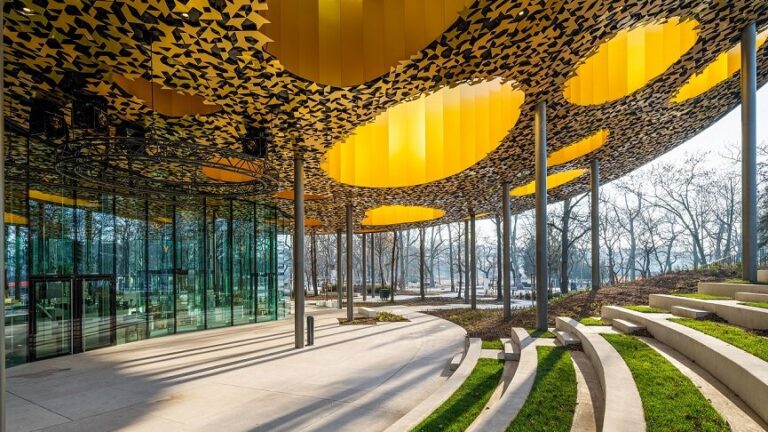On the Day of Hungarian Culture, the Prime Minister of Hungary, Viktor Orbán, inaugurated the House of Music, Hungary, which was completed within the Liget Budapest Project in the City Park, Budapest’s largest and most iconic public park. From 23 January 2022, the new institution will offer interesting musical programmes, an exciting and interactive permanent exhibition on the history of music, and a three-day series of events over the following weekend.
Designed by Japanese star architect Sou Fujimoto, this iconic building is a true masterpiece of contemporary architecture: with its organically undulating, perforated roof structure and huge glass walls, it is an unmistakable sight and is one of the most anticipated new buildings in the world by the international profession. The innovative exterior will house a complex music initiation centre, which will offer a wide range of programmes throughout the year, providing visitors with a myriad of musical experiences. The House of Music, Hungary was built on the site of former dilapidated office buildings, and around the new building, a 7,000 square metre green space that had been closed off and neglected for decades was renewed and turned back into a freely accessible park area in the City Park.
The House of Music, Hungary was built next to the Városliget lake, near the Vajdahunyad Castle and the City Park Ice Rink. Thanks to the construction work, which has been ongoing since 2018 and has now been completed, the Hungarian capital now has an iconic building designed by Japanese star architect Sou Fujimoto, a member of the world elite, and the people of Hungarian capital regained 7,000 square metres of green space, which had been closed off for decades and had been extremely neglected. Sou Fujimoto’s design was selected from 168 entries in an open competition in 2014. Since the announcement of the results, the project has received a lot of attention around the world: it has been named one of the most anticipated new buildings of 2021 by CNN and the World Architecture Community (WAC). The House of Music, Hungary has already been voted the world’s best public building for its design in 2019 at the prestigious International Property Awards in London, one of the most widely recognised awards in the real estate industry, and in 2020, it was awarded the top prize for the best music-themed development in the world: the Best Use of Music in Real Estate at the US Music Cities Awards.
Special programmes for visitors
One of the most important missions of the House of Music, Hungary is to bring the world of music closer to as many visitors as possible, by creating a place for a wider audience open to music, in addition to those who are already familiar with the field. The result is an institution that helps to showcase talent and supports both national and international musical collaborations. In this spirit, the debut programme of the House of Music, Hungary represents a very broad musical spectrum, from classical music to traditional and global music, from jazz to pop music, and electronic music.
The institution will be open to the public from 23 January, with young students from the Academy of Music filling the concert hall and the smaller auditorium with music during the day until 27 January. During the three days of the opening weekend that follows, visitors will get a taste of the institution’s diverse approach: on Friday 28 January, House of Music, Hungary will be opened by the St Ephrem Male Choir and the Doros Ensemble from Moscow, both highly acclaimed in Hungary and abroad. The event will also be the opening concert of the Orientale Lumen 2022 series (now in its eleventh year) and will take participants on a journey into the world of Eastern Orthodox music. On Saturday 29 January, the Veronaki band will welcome families with young children in the morning, the TanBorEn Trio will present a percussion show in the afternoon, and in the evening the Budapest band Deep Glaze, who recently released a new album, will perform. The opening weekend will close on 30 January with the Moldavian flute tunes performed by András Hodorog and his students at the Cleja Festival. The events of the opening weekend of the House of Music, Hungary and the full programme of the first half of the year can be found on the House’s website, where tickets are also available for purchase.
About the permanent exhibition of the House of Music, Hungary—Sound Dimensions—Musical Journeys in Space and Time
The permanent exhibition of the House of Music, Hungary, the first comprehensive permanent exhibition of music history in Hungary, takes visitors through the turning points of European, and especially Hungarian, music history. The exhibition, entitled Sound Dimensions—Musical Journeys in Space and Time, covers around 1,000 square metres and allows visitors to become interactive participants in an experiential story, using a headset. The music history adventure starts with the magical acts of the caveman, i.e., the moment of the birth of music, and continues with the roots of Hungarian folk music. The first turning point is the emergence of written music, followed by polyphony, and then the next turning point, the birth of opera. Visitors can „knock on the door” of the greatest masters, Haydn, Bach, Mozart, Beethoven, and virtual models will bring to life the 18th century European cities of importance to music history. The exhibition focuses on the personalities and importance of composers Ferenc Erkel and Ferenc Liszt, and also includes the 20th century, whose music history is unthinkable without Béla Bartók and Zoltán Kodály. But it is also a time of avant-garde musical experimentation, of innovative efforts, of the impact of technological advances, from the phonograph to the most modern recorders and electric instruments, which accompany the expansion of compelling popular music styles.
In addition to the permanent exhibition, a special experience will be the so-called sound dome, where you can discover the world of sound around you. The attraction, which can accommodate around 50 visitors at a time, covers an area of around 150 square metres next to the exhibition areas. The visitor is surrounded by a dome-shaped space with a projection screen stretched around it, where, in addition to the spectacle, the sounds around us can be heard through more than 30 speakers: from the sounds of nature to composed music, a wide range of sound effects can be heard. The visual and sound effects will combine to create a impressive experience of short films—or rather sound and image fantasies—projected here. The sound dome will also be a space for various musical experiments and art projects, in addition to educational activities.
Budapest has a contemporary architectural masterpiece
The vision of the designers of the new building dissolves the boundaries between the House of Music, Hungary and the City Park, and entering the building the visitor has the experience of still walking in nature. This sense of airiness and transparency is primarily due to the huge façade glass walls without horizontal structural division, exactly 94 of them, each individually manufactured and reaching a height of almost 12 metres in some sections. The harmonious fusion of house and nature is emphasised by the thousands of stylized plant leaf motifs in the suspended ceiling, whose golden hues constantly react to changes in light conditions. Another iconic feature of the house is its organic, floating roof structure, which the designer designed based on the visual image of sound vibration, the sound wave. Its roof has almost no angular elements, only undulating shapes; its surface is punctuated by almost 100 individually designed light wells, many of which channel natural light into the interior spaces, creating a unique atmosphere.
The unique exterior of the building is matched by a unique interior design; the complex musical, pedagogical and programme offer of the House of Music, Hungary are reflected in the triple-level layout of the building. The spaces below ground floor are dedicated to exhibitions, with permanent and temporary exhibitions covering a total of around 2,000 square metres, and the unique sound dome is also located here. The park level is dedicated to the performing arts, with concert halls and an open-air stage for live music. The first floor of the building offers bright but well-organised spaces for reflection and education. Here you will find the digital archive, which mainly contains many documents on the history of Hungarian popular music, the multimedia library and club, and the music education rooms.
Acoustic bravura—the special sound of the concert hall
A concert hall with glass walls is a rarity worldwide. It is exciting and unique in terms of its visual impact, but at the same time it is a huge challenge for both the designer and the contractor in terms of acoustics. However, it was a Japanese company with vast international experience, Nagata Acoustics, which designed the acoustics for the Walt Disney Concert Hall in Los Angeles, the Elbphilharmonie in Hamburg, the Mariinsky Theatre in St Petersburg, and the Philharmonie de Paris.
In developing the acoustics for the House of Music, Hungary, Nagata Acoustics worked closely with the designer Fujimoto from the beginning, and approached the challenge applying innovative solutions. Instead of large, connected glass surfaces, a slightly smaller and zigzag-shaped wall has been created, because the (incoming) sound that hits the wall is not reflected directly but diffused back from the surface, resulting in a homogeneous sound. Nagata Acoustics carried out measurements for a week after the completion of the concert hall: the room was tested first without a sound system, then with acoustic instruments (solo flute, string quartet, folk instruments), and finally with sound system. During the rehearsals, they found that the same excellent acoustic sound quality could be heard anywhere in the room.











